Science Highlights, July 8, 2015
Awards and Recognition
Capability Enhancement
Plasma spray system enables coating full-sized fuel rods
First tests of thermal-neutron-induced semiconductor failures
Science on the Roadmap to MaRIE
New spectrometer enables advances in high energy density physics research
Awards and Recognition
Benno Schoenborn chosen for Bau Neutron Award
Benno Schoenborn
The American Crystallographic Association (ACA) has selected Benno Schoenborn (formerly Bioenergy and Biome Sciences, B-11) to receive the 2016 Bau Neutron Award. The Award recognizes exceptional research achievement in neutron diffraction. Schoenborn is the second recipient of this triennial award. The award honors Schoenborn for his pioneering research in macromolecular neutron crystallography and the design and development of the neutron crystallography beamline (Protein Crystallography Station, PCS) at the Los Alamos Neutron Scattering Center (LANSCE).
Schoenborn is a Laboratory Senior Fellow who retired from the Lab 2013. Before coming to Los Alamos, he worked at Brookhaven National Laboratory where he conducted innovative work in macromolecular neutron crystallography, beginning with the very first neutron structure of myoglobin in 1969. Neutron crystallography uses neutron diffraction to elucidate protein structures: when a beam of neutrons hits a crystallized protein, they are scattered by the crystal and their diffraction pattern recorded. This approach reveals information about the location of hydrogen atoms, which provides insight for enzyme mechanisms, hydrogen bonding, and water structure in macromolecules.
Schoenborn has been called the “father of neutron crystallography”. He performed his first demonstration of this technique at a time when few scientists believed that it was even possible. Schoenborn persevered and proved that neutron diffraction of macromolecular crystals was not only possible but that the information gleaned was unique and extremely useful Upon arrival at LANL in 1993, Schoenborn began work on designing and building the first neutron protein crystallography beamline (the Protein Crystallography Station, PCS) at a spallation neutron source at LANSCE. Schoenborn, with colleagues Eric Pitcher, Phil Ferguson, and later Paul Langan, designed every component of the PCS to maximize the neutron intensity and reduce background scattering. This achievement enabled scientists to collect excellent data in 15 to 30 days of beam time using small protein crystals. The big payoff was that the larger proteins, for which large crystals are nearly impossible to grow, became amenable to neutron crystallography.
Upon completion, in 2002, the PCS was the first macromolecular crystallography beamline at a spallation neutron source, until the completion of the iBIX station in Tokai, Japan, in 2008. The PCS remained the only macromolecular crystallography station in North America until the commissioning of the TOPAZ / MaNDi / IMAGINE instruments at Oak Ridge National Laboratory starting in 2010. The PCS has been used as an example for this type of instrument in construction of similar beamlines at the Australian Nuclear Science and Technology Organisation and Oak Ridge National Laboratory. Over the last 14 years, research at LANL’s PCS has revealed a number of unexpected and critical data on enzyme mechanisms and highlighted the unique characteristics and chemistry of enzyme active sites. The data have proved to be critical for drug design and protein engineering.
The award is given in memory of Professor Robert Bau, University of Southern California (1969-2008) and President of the American Crystallographic Association in 2006. Professor Bau made major contributions to the development of the technique of single-crystal neutron diffraction and to its applications in chemical and biomacromolecular crystallography. This award recognizes exceptional research achievement in neutron diffraction.
The American Crystallographic Association, Inc. is a nonprofit, scientific organization of over 2,200 members in more than 60 countries. Founded in 1949, the Association promotes interactions among scientists who study the structure of matter at atomic (or near atomic) resolution. These interactions advance experimental and computational aspects of crystallography and diffraction. Understanding the nature of the forces that both control and result from the molecular and atomic arrangements in matter will provide insight into chemical interactions in nature and could lead to treatments for disease. Technical contact: Srinivas Iyer
John Bliss named Fellow of the Health Physics Society
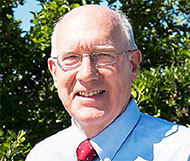
John Bliss
The Health Physics Society has given John Bliss (ESH Deployed Services, DSESH-EWMO) the title of Fellow for his significant scientific contributions to the profession of health physics. He will be presented an award at the annual meeting of the Health Physics Society July 12-16 in Indianapolis.
Bliss joined the Laboratory in 1997 and has been in the radiation protection program since 1999. He was the Health Physics Operations group leader for more than 7 years and has recently been the acting Environment Safety and Health manager for Environment and Waste Management Facility Operations. He serves as a deployable member of the DOE Accident Response Group and as an assessment scientist for the Federal Radiological Monitoring and Assessment Center. He is highly regarded as a senior radiological expert and is routinely called upon to engage in problem solving for difficult radiological issues.
Bliss earned a master’s degree in nuclear engineering from Texas A&M University. He entered the United States Army as an infantry officer and then as a health physicist in the Medical Service Corps, retiring after 22 years as a lieutenant colonel. He supported numerous radiological activities, including those at the White Sands Missile Range and the U.S. Army Nuclear and Chemical Agency. He supported the U.S. Ambassador to the Soviet Union in Moscow following the accident at Chernobyl and worked with the North Atlantic Treaty Organization, where he served as the international chairman of a working group on low-level radiation in military operations.
The Health Physics Society, formed in 1956, is a scientific organization of professionals who specialize in radiation safety. It supports its members in the practice of their profession and promotes excellence in the science and practice of radiation safety. Its nearly 5,000 members represent all scientific and technical areas related to radiation safety, including academia, government, medicine, research and development, analytical services, consulting and industry in the United States. Technical contact: John Bliss
Claudia Mora selected to lead the American Geological Society
Claudia Mora
The Geological Society of America (GSA) has elected Claudia Mora (Earth System Observations, EES-14) as vice president/president elect. Mora is a stable-isotope geochemist whose research spans the traditional fields of geology, soil science and climate science.
Mora earned a PhD in geology from the University of Wisconsin-Madison. She was the first woman on the University of Tennessee-Knoxville geoscience faculty, where she was head of the Department of Earth and Planetary Science for 18 years and won awards for research, teaching, and leadership. Mora joined Los Alamos in 2007 and established a stable-isotope analytical laboratory that has supported programs in climate science, biofuels, forensics and nonproliferation. She has also contributed significantly to studies of crustal fluid-rock interaction at high temperatures and pressures. Her application of secondary ionization mass spectrometry for stable-isotope analysis has helped define the rates and scales of crustal rock alteration. At Los Alamos, Mora heads the Earth and Environmental Sciences Division’s largest group, Earth System Observations. This group’s research is broad and far-reaching, intersecting geology, ecology and atmospheric sciences.
In addition to her GSA service, Mora previously served on the National Research Council Board on Earth Sciences and Resources, the National Science Foundation Geoscience Advisory Board, and the U.S. National Committee for Soil Sciences. She has served a three-year appointment as a member of the Board of Earth Sciences and Resources (BESR) of the National Research Council (NRC).
The Geological Society of America is a global professional society with more than 27,000 members in 115 countries. Mora has served GSA since 1993 on multiple leadership committees and as a councilor, and she will serve a three-year presidential cycle. Technical contact: Claudia Mora
Capability Enhancement
Plasma spray system enables coating full-sized fuel rods
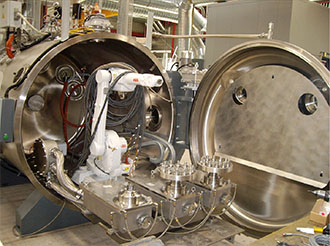
Photo. Plasma spray vacuum chamber with articulated robot and turntable similar to the funded LANL system.
NNSA has awarded the Laboratory $4 M for the purchase and installation of a new vacuum plasma spray system in support for the DOE NNSA Reactor Conversion Program. The program aims to reduce nuclear proliferation risks by converting highly enriched uranium research reactor fuel to low enriched (less than 20% uranium) fuel. NNSA NA-23 granted the funding to LANL based on successful R&D work the Lab has conducted for the program and the Laboratory’s demonstration of plasma sprayed zirconium coatings for small-scale mockups of the research reactor fuel.
The new plasma spray system will allow Metallurgy (MST-6) researchers working in the Sigma Complex to scale up current work to create fuel plates as large as 1220-mm-long by 130-mm-wide. This system will accommodate the largest fuel used in any of the high performance research reactors in the United States. Coating full-sized reactor fuel enables testing a new fuel design to ensure its performance and safety. The fuel plates containing the coated fuel will be tested in the Advanced Test Reactor at Idaho National Laboratory to demonstrate in-reactor performance and establish a basis for Nuclear Regulatory Commission certification of the new low enriched uranium fuel.
This system will be the first of its kind in the United States with the ability to accommodate large parts at long standoff distances with high plasma power and low processing pressures. This combination is essential when MST-6 researchers apply a diffusion barrier coating of zirconium to uranium 10% molybdenum alloy fuel. This coating will prevent reactions between the fuel and the aluminum cladding.
The new vacuum chamber for plasma spraying is 4-meters-long by 2.5 meters in diameter and will contain a 6-axis articulated robot to manipulate the parts to be coated and the plasma torch inside the chamber. The plasma system can be operated at powers up to 200 kW at pressures between 0.5 mbar and local atmospheric pressure. These capabilities combine to allow coating deposition under particulate or vapor conditions.
The successful installation of this system required a broad range of Laboratory experts, including scientists, technicians, project, and acquisition professionals. The team includes: David Dombrowski, Chris Chen, Dustin Cummins, Don Bucholz, Amber Telles, Barry Bingham, Holly Dodge, Mark Paffett, and Kendall Hollis (MST-6); Mary Durren (STO and WFO PM FODS, PM-9); Rhonda Hanson (Program Cost and Scheduling, MOF-CS-PCS); and Miguel Ortiz (Acquisition Services, ASM-PUR). Deborah Dale (Nuclear Engineering and Nonproliferation, NEN-DO) is the Los Alamos NA-23 program manager. This work supports the Lab’s Global Security and Energy Security mission areas and the Materials for the Future science pillar via the capability to coat full-sized reactor fuel rods for testing. Technical contact: Kendall Hollis
First tests of thermal-neutron-induced semiconductor failures
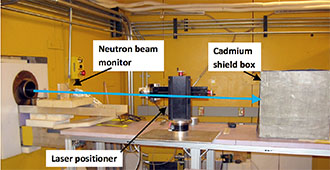
Photo. Inside the experimental cave on Flight Path 12 at the Lujan Center, where Los Alamos has established a capability to test thermal-neutron-induced semiconductors. The LANSCE beam enters from the left and passes through a neutron monitor before entering a cadmium shield box housing the semiconductor test board.
The Los Alamos Neutron Science Center (LANSCE) has an unparalleled ability to assess semiconductor failures from high-energy neutrons. LANSCE utilizes high-energy neutron sources produced at Target-4 in the Weapons Neutron Research (WNR) Facility. Industrial users have been testing electronics at WNR since the 1990s. Now, Los Alamos researchers have used a flight path developed at Target-1 at the Lujan Center (a LANSCE facility) to measure the failure rate in semiconductor devices at thermal neutron energies.
For the first time, Lab researchers and Honeywell Aerospace have measured the effect of thermal neutrons (neutrons in thermal equilibrium with their environment). The long-time LANSCE industry user performed a thermal neutron test on an integrated circuit that had been characterized previously at a reactor. The LANSCE and reactor test results agreed in the number of observed failures per thermal neutron. The successful demonstration of this capability could enable LANSCE to expand its role in semiconductor radiation effects testing.
High-energy neutrons, produced in the atmosphere by cosmic rays striking oxygen and nitrogen atoms in the air and undergoing a nuclear reaction, can thermalize (lose energy to achieve thermal equilibrium with their environment) in the surrounding materials and interact with the semiconductor devices. Boron-10 (20% of natural boron) is found in semiconductor devices. This isotope is of particular concern for many applications due to its vulnerability to thermal neutrons. Boron-10 has a large thermal neutron cross section and produces a charged particle that can cause failure when it is deposited in a sensitive semiconductor volume. Efforts to remove boron from semiconductor devices have been unsuccessful.
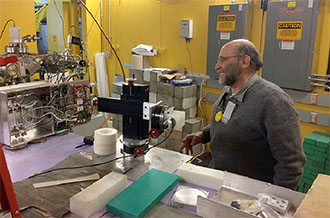
Photo. Steve Wender has been aligning beams for companies from around the world since the early 1990s, when LANSCE became known as one of the few places where researchers can characterize semiconductor components and study various failure modes caused by neutron radiation.
Heather Quinn (Space Data Systems, ISR-3) and Matt Devlin, Michael Mocko, and Steve Wender (LANSCE Weapons Physics, P-27) took measurements for a variety of semiconductor devices. They recorded the number of device failures with and without a cadmium shield. Cadmium has a large absorption cross section at thermal and below neutron energies. Therefore, the difference in the failure rate with and without cadmium in the beam reflects the effect of thermal neutrons. As expected, preliminary results revealed a range of failure rates for different semiconductor devices. Based on these data, the failure rate in a specific environment, such as space, could be determined. If the failure rate is thought to be too high, a different device may have to be used for some applications.
LANSCE developed this new technology in response to the semiconductor community, which continues to view neutrons as a serious threat to integrated circuit reliability. As semiconductor feature sizes become smaller and operating voltages become lower, the odds of failure increase. The new LANSCE results benefit space and avionics electronics applications.
Industry partly funded the work. This is an example of putting the Laboratory’s unique capabilities to use for science in service to society. The work supports the Laboratory’s Global Security mission area and the Nuclear and Particle Futures science pillar. The research benefited from the use of the Lujan Center, which the National Nuclear Security Administration funds. For more information on these and other LANSCE nuclear science capabilities, see the LANSCE Focus on Nuclear Science publication: http://lansce.lanl.gov/news/pulse.shtml. Technical contact: Steve Wender
Chemistry
Chemistry researchers to assist NM Algae LLC
Researchers in Chemistry Division are providing technical expertise through a work for others (WFO) agreement to New Mexico Algae LLC located in La Cienega, NM. The goal is to develop a large-scale, multi-stage, continuous culturing process for the growth of algae that produce the nutritional supplement astaxanthin.
Astaxanthin is a high-value carotenoid pigment produced by a variety of organisms in nature. The alga Haematococcus pluvialis produce astaxanthin for the protection of cellular constituents in a stress response to harsh environmental conditions. Primary stressors include low nutrient levels, intense light, desiccation, and elevated salt concentrations present in the medium in which they live. These factors induce a physiological and morphological change in the cells, which causes a dramatic transformation from a swimming, green vegetative state to a bright red astaxanthin laden spore form known as a haematocyst. These spore-like structures may contain up to 3% astaxanthin by weight when dried. The cysts convert back into the motile cell form when favorable conditions return.
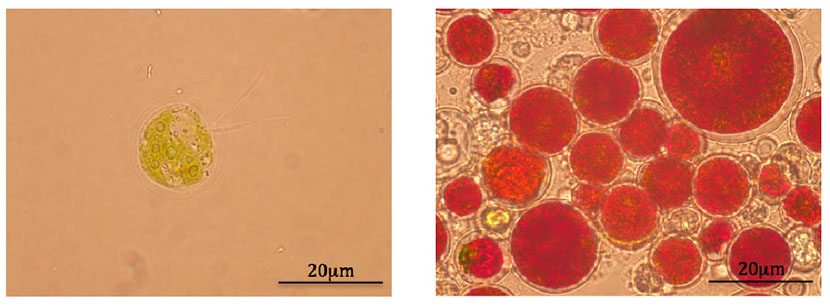
Figure 1. Microscope images of Haematococcus pluvialis: (left) green vegetative state and (right) haematocyst.
Astaxanthin is best known for its commercial use as a nutritional supplement in fish feed. The molecule imparts the pinkish color to the flesh of farm-raised salmon and deepens the yellow color in the yolks of chicken eggs. There is a growing market for an organically certifiable source of astaxanthin for use as a nutraceutical for human consumption. For this purpose the H. pluvialis haematocysts are typically “cracked” to increase digestibility and ingested as whole dried cells in capsule or tablet form. Astaxanthin has higher antioxidant capacities than either vitamin E or b-carotene. Proponents of astaxanthin use report health benefits that range from reduced gastric inflammation to beneficial effects for vision such as slowing of macular degeneration. The current market price for dried H. pluvialis is up to $500 per pound depending on astaxanthin content.
The largest commercial growers of H. pluvialis are in Hawaii. They use open raceways to produce large-volume cultures of the alga. These growers closely guard their methods as proprietary information. In order to grow Haematococcus under more controlled conditions, New Mexico Algae LLC has developed a unique process that utilizes an open tank, semi-continuous culture system with a regular stress and harvest regime. The company conducts this culturing process in greenhouses that provide the appropriate environment for the commercial scale growth of an organically certifiable product suitable for human consumption.
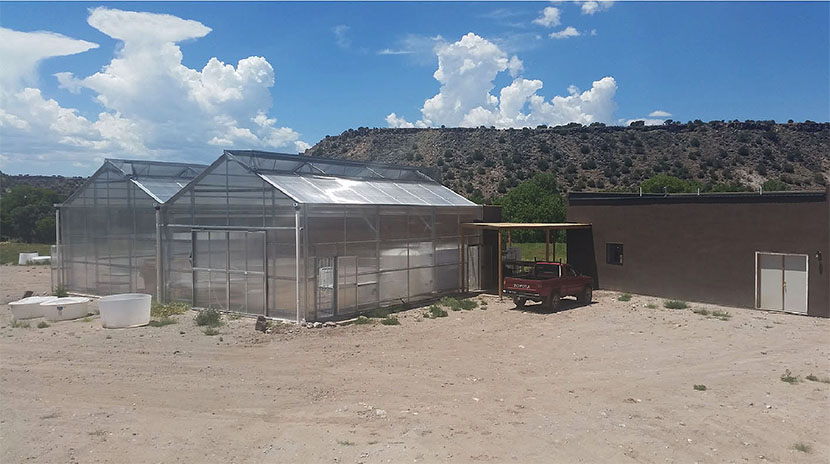
Photo. New Mexico Algae LLC greenhouse in La Cienega, NM.
New Mexico Algae LLC approached LANL for assistance in developing culture conditions that would optimize their process. Principal Investigator Greg Wagner (Physical Chemistry and Spectroscopy, C-PCS) provides expertise in algal metabolism with focus on growth phase and haematocyst maturation. He and others are testing fine tuned nutrient formulations in conjunction with regular feed/harvest routines for chemostatic growth of the H. pluvialis cultures. They have demonstrated a bench-top method that maintains cultures in a phase of growth for rapid cell division and conversion to haematocysts in a short timeframe. The ongoing collaborative work addresses the challenges of scale-up, harvesting, and the transition to large-scale astaxanthin production at the La Cienega facility.
Additional technical contributions from LANL include: spectroscopy expertise from Fran Rein-Rocha (Inorganic, Isotope and Actinide Chemistry, C-IIAC) and Dung Vu (C-PCS), imaging expertise from Kristy Nowak-Lovato (C-PCS), and culture monitoring by Nadia Mabrouk-Mujynya (C-PCS).
An ongoing Work for Others (WFO) agreement between LANL and New Mexico Algae LLC funded this work. Previous projects with New Mexico Algae LLC, funded by the Los Alamos National Laboratory New Mexico Small Business Assistance program, were leveraged to launch the WFO effort. The research supports the Lab’s Energy Security mission area and the Materials for the Future science pillar. Technical contact: Greg Wagner
Materials Physics and Applications
New design principles boost performance of solar cells
Los Alamos researchers and University of Minnesota collaborators cleared what they call a long-standing bottleneck in the field of organic electronic devices. The team has discovered key interface charge transport dynamics that must be understood in order to control charge and energy transport across interfaces in organic electronics. In addition, the scientists have demonstrated interface design principles that could significantly raise power conversion efficiency in organic solar cells. When applied to practical device architectures such as bulk heterojunction solar cells, these strategies can boost the overall power conversion efficiency from approximately 4.0% to greater than 7.0%. Advanced Science published the findings.
The researchers investigated three distinct types of interface functional spacer layers between the donor and acceptor of an organic photovoltaics device. The results demonstrated that the power conversion efficiency can be dramatically improved by as much as approximately 2–5 times in a model bilayer device. The three independent interface modification strategies dramatically suppress the interface charge-transfer (CT) state recombination. Similar interface design strategies could be applicable to a wide range of hybrid material systems with organic–inorganic and inorganic–inorganic interfaces such as perovskite solar cells, atomic layered 2-D interfaces, nanostructured systems such as quantum dots, and single-wall carbon nanotubes for the development of next generation, high efficiency light to energy conversion optoelectronic devices.
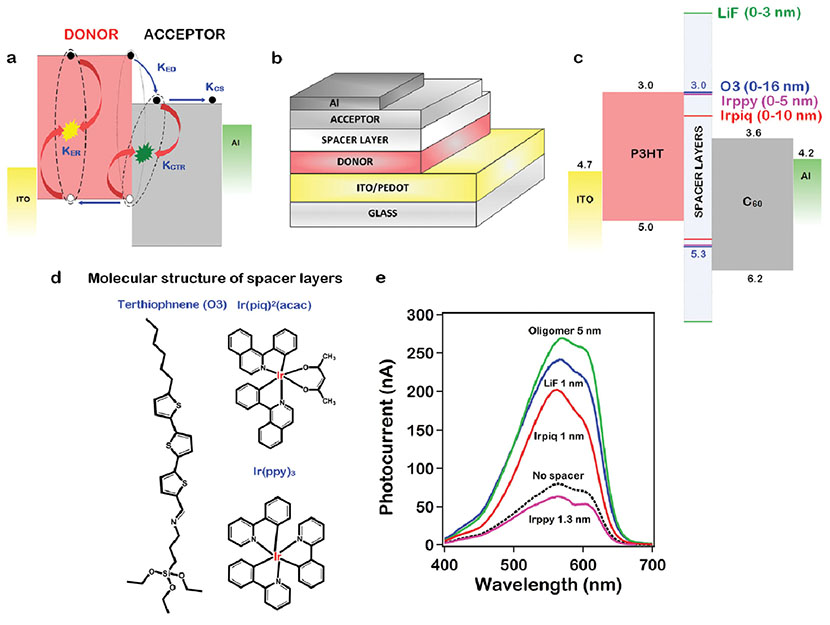
Figure 2. a) Photophysical processes and corresponding generation/dissociation/recombination rates in organic solar cells during device operation. b) Model bilayer device architecture. c) Strategies used to insert spacer layers at the P3HT/C 60 [regio-regular Poly(3-hexylthiophene-2, 5-diyl /fullerene] interface and the energy level alignment of P3HT (donor) and C 60 (acceptor) with respect to spacer levels. d) Molecular structures of O3 [terthiophene-derivative], Irpiq [(bis(1-phenylisoquinoline)-(acetylacetonate) iridium (III)], and Irppy [tris(2-phenylpyridine)iridium (Irppy)] spacer layers. e) Photocurrent versus excitation wavelength measured under short-circuit conditions without (dashed black curve) and with (solid color curves) spacer layers. Peaks in the photocurrent spectra match well with the absorbance of P3HT.
Reference: “Interface Design Principles for High-Performance Organic Semiconductor Devices,” Advanced Science 2, 1500024 (2015); doi: 10.1002/advs.201500024). Authors include: Wanyi Nie, Gautam Gupta, Brian Crone, and Aditya Mohite (Material Synthesis and Integrated Devices, MPA-11); Darryl Smith (Physics of Condensed Matter and Complex Systems, T-4); Hui Li (Nuclear and Particle Physics, Astrophysics and Cosmology, T-2); Sergei Tretiak (Physics and Chemistry of Materials, T-1); Cheng-Yu Kuo, Hsinhan Tsai, and Hsing-Lin Wang (Physical Chemistry and Applied Spectroscopy, C-PCS); Feilong Liu and P. Paul Ruden (University of Minnesota).
The DOE Office of Basic Energy Sciences and the Los Alamos Laboratory Directed Research and Development (LDRD) program funded different aspects of the work, which supports the Laboratory’s Energy Security mission area and Materials for the Future science pillar through technological advances in solar energy. Technical contact: Aditya Mohite
Physics
Neutron spectra measurements obtain uranium-235 data in previously unexplored region
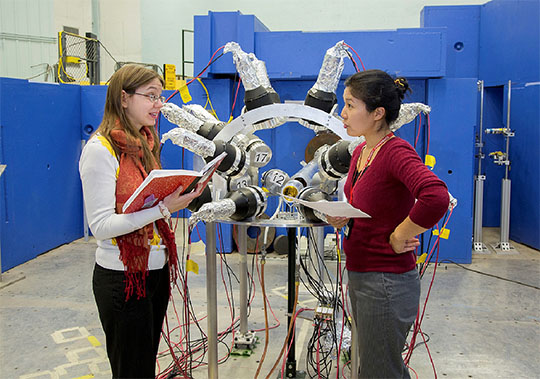
Photo. Denise Neudecker (Nuclear and Particle Physics, Astrophysics and Cosmology, T-2) (left) and Hye Young Lee (LANSCE Weapons Physics, P-27) discuss the uranium-235 data in the Chi-Nu experimental area. The array of neutron detectors surrounding the fission chamber is behind them.
Researchers used a challenging combination of two time-of-flight measurements on the Chi-Nu experiment at the Los Alamos Neutron Science Center (LANSCE) to demonstrate important aspects of the physics behind nuclear reactions at the low end of the fission neutron spectrum (below 0.5 MeV). The preliminary, unpublished experimental results on uranium-235 (235U) appear to uphold what nuclear reaction models had predicted – that this end of the spectrum is similar to fission induced by thermal neutrons.
The discovery of nuclear chain reactions in the fission of uranium and plutonium nearly 80 years ago made nuclear reactors and nuclear weapons possible. When a nucleus fissions, several neutrons are released. These neutrons can induce fission in neighboring nuclei to create the chain. The probability of subsequent reactions depends on the energy of the fission neutrons. This is what the Chi-Nu experiment is designed to measure. Neutrons emitted in fission can have a wide range of energies, and the distribution of these energies (the spectra) can vary with the energy of the incident neutron that causes the fission.
Two neutron energies are of importance: the energy of the neutron inducing the fission and the energy distribution of the neutrons produced in the fission. The Chi-Nu experiment studies fission induced by “fast neutrons;” that is, those with energies much above thermal, in the million-electron-volt (MeV) region. For fission induced by these fast neutrons, there have been no previous measurements of the low end of the fission neutron spectrum (below 0.5 MeV). This is an essential component of the full spectrum.
Chi-Nu’s array of 22 lithium glass neutron detectors used in this work is specialized for the part of the neutron emission spectrum below 0.5 MeV. The team performed the experiment at the LANSCE/WNR neutron source of pulsed fast neutrons. The recent upgrade of the LANSCE accelerator enabled an increase in the intensity of the neutron source by a factor of 2.5. An advanced data acquisition system based on waveform digitizers took advantage of this improved accelerator performance.
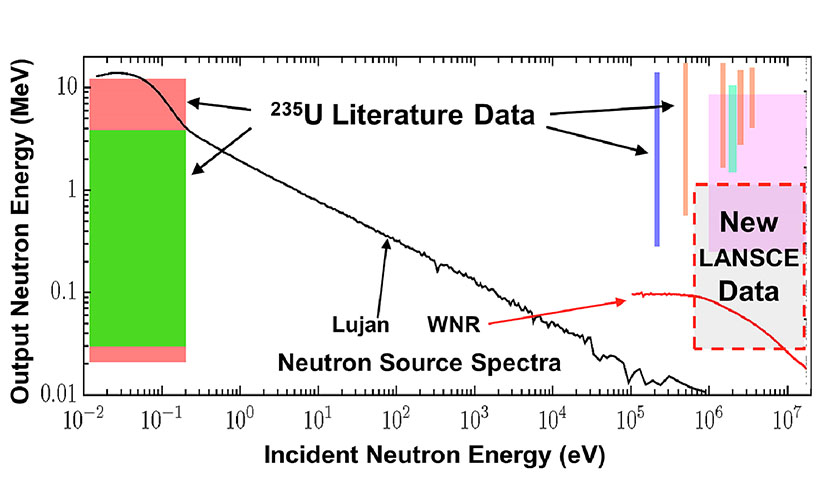
Figure 3. Location of the new WNR/LANSCE data for prompt fission neutrons from neutron induced fission of uranium-235. The location of previous and the present data are given by the areas in the plot of incident neutron energy (horizontal axis) versus outgoing neutron energy (vertical axis). The ranges of incident neutron energies available at the Lujan Center and at WNR are shown.
LANL and Lawrence Livermore National Laboratory scientists used a “double” time-of-flight approach at the LANSCE Weapons Neutron Research (WNR) Facility. The researchers identified the energy of the neutrons causing the fission (first time-of-flight) and measured the energy of the emitted neutrons (second time-of-flight). The first time-of-flight measurement from the neutron source to the fission chamber gives the energy of the neutron inducing the fission. The second measurement, the time from the fission detector to the neutron detector 40 cm away, determines the energy of the fission neutrons. Nuclear models had predicted that the spectrum would not change rapidly with incident neutron energy. This is the first experimental verification of that theory.
In future experiments, scientists will use a different array of Chi-Nu detectors to measure the higher energy part of the uranium-235 fission neutron spectrum. The researchers aim to resolve significant discrepancies reported in the literature. They also plan to investigate both the low- and high-energy regions of the neutron spectra for fission of plutonium-239, an isotope that presents measurement challenges due to the natural alpha-particle radioactivity of the samples.
Los Alamos researchers include: Robert Haight, Hye Young Lee, Terry Taddeucci, John O’Donnell, Shea Mosby, Matt Devlin, Nikolaos Fotiadis, Ron Nelson, and Steve Wender (LANSCE Weapons Physics, P-27); Todd Bredeweg (Nuclear and Radiochemistry, C-NR); Denise Neudecker (Nuclear and Particle Physics, Astrophysics and Cosmology, T-2); Morgan White (Materials and Physical Data, XCP-5); and C. J. Solomon (Monte Carlo Codes, XCP-3).
NNSA Science Campaign 1: Primary Assessment Technologies (LANL Program Managers Mark Chadwick, Steve Sterbenz, and Morgan White) funded the research, which supports LANL’s mission areas of Nuclear Deterrence, Global Security, and Energy Security and the Laboratory’s Nuclear and Particle Futures science pillar. Technical contact: Robert Haight
Science on the Roadmap to MaRIE
New spectrometer enables advances in high energy density physics research
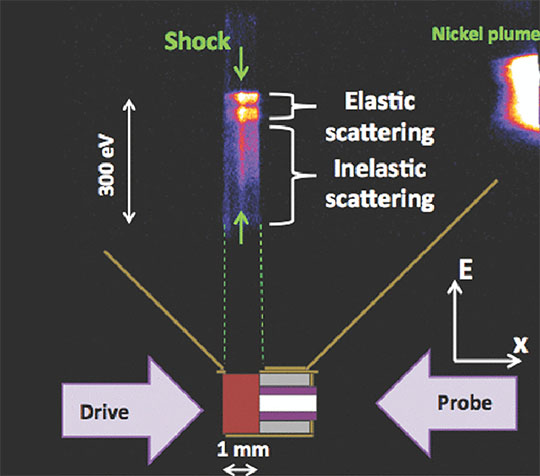
Figure 4. An example of using the iXTS to diagnose a strong shock driven in a carbon foam. The x-ray source in this experiment was generated from a laser-heated nickel (Ni) plasma producing Ni He- x-rays at 7.8-keV.
Laboratory researchers used their expertise in x-ray imaging to collaborate with the University of Michigan to develop a diagnostic for physics experiments. The team developed an imaging x-ray Thomson spectrometer (iXTS) for experiments at Los Alamos National Laboratory’s Trident Laser Facility and the University of Rochester’s Omega Laser Facility.
Scientists have used this instrument primarily to provide high-resolution imaging x-ray scattering measurements for warm dense matter and high energy density experiments. They have also utilized it in dynamic x-ray fluorescence imaging and x-ray emission measurements. The sophisticated capability of iXTS has led to advances in the understanding of warm dense matter and strong shock propagation in the high-energy-density (HED) regime. Researchers plan future experiments using this diagnostic to measure plasma conditions of turbulence in high-energy-density regimes.
iXTS also constitutes a contribution in kind pledged by Los Alamos National Laboratory to the Helmholtz International Beamline for Extreme Fields (HIBEF) of the European X-Ray Free-Electron Laser (XFEL), under the aegis of a memorandum of understanding between Los Alamos and the Helmholtz Zentrum Dresden Rossendorf, the lead institution for HIBEF.
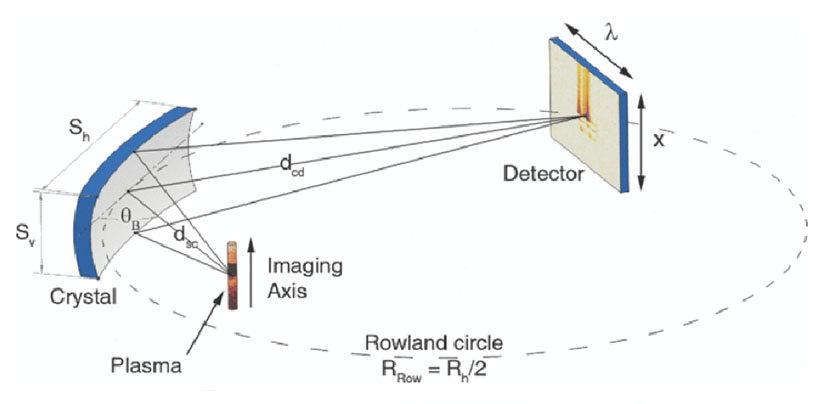
Figure 5. A schematic of the toroidal imaging crystal spectrometer arrangement.
Los Alamos researcher David Montgomery (Plasma Physics, P-24) developed the concept for the instrument, designed, and built the first prototype. He also led development of the final instrument
design for applications at Trident and Omega. The iXTS instrument consists of a toroidally curved ideal crystal (such as germanium), and a CCD camera for measurement readout. The instrument in its present configuration has a spatial resolution of 25 μm, a spectral resolution of 4 eV at 8 keV, an imaging magnification of 2, and a throughput of 4 x 10-5 sR. In principle, higher spatial resolution could be achieved with higher magnification without sacrificing throughput. Conceptual designs exist for these configurations.
The instrument’s development is an example of progress on the path to diagnostic capabilities needed for MaRIE (Matter-Radiation Interactions in Extremes), the Laboratory’s proposed experimental facility for control of time-dependent material performance. MaRIE would introduce the world’s highest energy hard x-ray free electron laser, which could help accelerate discovery and design of the advanced materials needed to meet 21st-century national security and energy security challenges. Thomson scattering is one of the diagnostic techniques planned for MaRIE experiments, and a future version of this spectrometer would enable such measurements there.
References:
“Simultaneous Measurements of Several State Variables in Shocked Carbon by Imaging x-ray Scattering,” Physics of Plasmas 21, 042701 (2014); doi: 10.1063/1.4869241. Authors include: E. J. Gamboa, R. P. Drake, P. A. Keiter, and M. R. Trantham (University of Michigan) K. Falk (Safeguards Science and Technology, NEN-1), D. S. Montgomery and J. F. Benage (P-24).
“Equation of State Measurements of Warm-dense-carbon using Laser-driven Shock and Release Technique,” Physical Review Letters 112, 179902 (2014); doi: 10.1103/PhysRevLett.112.155003. Authors include: K. Falk (NEN-1), E. J. Gamboa (University of Michigan), G. Kagan and B. Srinivasan (Applied Mathematics and Plasma Physics, T-5), D. S. Montgomery and J. F. Benage (P-24), and P. Tzeferacos (University of Chicago).
“Combined x-ray Scattering, Radiography, and Velocity Interferometry/streaked Optical Pyrometry Measurements of Warm Dense Carbon using a Novel Shock-and-release,” Physics of Plasmas 21, 056309 (2014); doi: 10.1063/1.4876613. Authors include: K. Falk (NEN-1), L. A. Collins and J.
D. Kress (Physics and Chemistry of Materials, T-1), E. J. Gamboa (University of Michigan and SLAC National Accelerator Laboratory), G. Kagan and B. Srinivasan (T-5), D. S. Montgomery and J. F. Benage (P-24), and P. Tzeferacos (University of Chicago).
“Spatially-resolved x-ray Scattering of a Planar Blast Wave,” High Energy Density Physics 11, 75 (2014); doi: 10.1016/j.hedp.2014.03.002. Authors include: E. J. Gamboa, P. A. Keiter, and R. P. Drake (University of Michigan); K. Falk (NEN-1); D. S. Montgomery and J. F. Benage (P-24).
“Demonstration of x-ray Fluorescence Imaging of a High-energy-density Plasma,” Review of Scientific Instruments 85, 11E602 (2014). Authors include: M. J. MacDonald, P. A. Keiter, J. R. Fein, E. J. Gamboa, S. R. Klein, C. C. Kuranz, H. J. LeFevre, M. J. Manuel, W. C. Wan, and R. P. Drake (University of Michigan); D. S. Montgomery (P-24); M. M. Biener and K. B. Fournier (Lawrence Livermore National Laboratory); and J. Streit (Schafer Corporation).
The NNSA Science Campaigns (LANL Program Managers Steve Batha, Campaign 10 and Steve Sterbenz, Campaign 1) funded the development, construction, and testing of iXTS. The instrument supports the Lab’s Nuclear Deterrence mission area and the Science of Signatures science pillar through the development of a diagnostic to image warm dense matter, strong shock propagation in the high-energy-density regimes, and plasma turbulence. Technical contact: David Montgomery
Theoretical
Simulating helium bubble behavior in fusion reactors
One of the most important challenges for the successful commercialization of fusion power is the development of plasma facing materials that can tolerate the extreme conditions of elevated temperatures and high particle flux of hydrogen isotopes and helium present in fusion reactors. Researchers designing the ITER fusion reactor plan to use tungsten – one of the toughest materials known – as a plasma-facing material. However, despite tungsten’s relative strength, there is concern about how the plasma could affect the tungsten over time. A Laboratory team performed simulations to understand more fully how tungsten behaves in such harsh conditions, particularly in the presence of implanted helium (He) that forms bubbles in the material. The journal Physical Review Letters published the team’s research. The Los Alamos scientists hope that by better understanding the interactions between helium bubbles and tungsten, they can predict the evolution of the material and mitigate concerns over tungsten in the reactor.
ITER is a large-scale, international scientific experiment that is under construction in France. The experiment aims to demonstrate the technological and scientific feasibility of fusion energy, the same process that powers stars. Scientists will use two hydrogen isotopes, deuterium and tritium, to create a plasma that they will send around the tokamak at very high temperatures – between 10 million and 100 million degrees kelvin. The deuterium and tritium will collide in this extreme environment, fuse together to form a helium atom, and release a very energetic neutron.
As these helium particles bombard the tungsten wall, they begin to form clusters within the material. When enough helium atoms are bunched together, they can “knock out” a tungsten atom from its normal position to form a nanoscale cavity within the tungsten. This acts as the nucleus of a helium bubble that can then grow very large, reducing the durability of the material. These bubbles also serve as traps for tritium, which reduces the amount of tritium available for the fusion reaction and introduces a radiological hazard. In addition to tritium retention, helium bubbles cause other problems. As they cluster together and push out tungsten atoms, the tungsten surface develops a fuzz-like nanostructure. The concern is that these nanoscale wires could erode into the plasma, degrading its quality, cooling the fusion reaction, and hence making it far more difficult to maintain.
Therefore, understanding how He bubbles nucleate and grow is of primary importance for predicting the large-scale evolution of the material. The LANL researchers combined accelerated molecular dynamics (AMD), an approach to extend the time scale of atomistic simulations beyond conventional molecular dynamics while retaining full atomic fidelity, with leadership-class computing to simulate the evolution of helium bubbles at He implantation rates relevant for the conditions at ITER. The team used the Parallel Replica (ParRep) method, developed at Los Alamos, to achieve a drastic speedup in computing. The scientists examined the growth of helium bubbles in tungsten for growth rates spanning six orders of magnitude. The team discovered that there are two growth regimes, which are governed by the mobility of interstitials on the bubble surface.
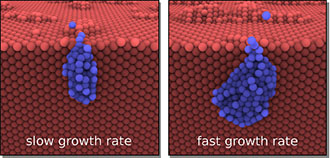
Figure 6. Simulation snapshots of the helium bubble just before bursting when grown at slow versus fast rates. The colors indicate tungsten atoms (red) and helium atoms (blue). At slow rates, the bubble experiences the influence of the surface more readily, and growth is more directed toward the surface. At fast rates, the bubble grows more isotropically and reaches a larger size before bursting. This creates more surface debris.
The simulations revealed that at the high He implantation rates typical of previous calculations, the tungsten atoms surrounding the bubble do not have time to respond to the accumulated pressure. This results in highly overpressurized bubbles that grow to large sizes and burst violently upon reaching the surface of the material. In contrast, once the He implantation rate is reduced to more realistic values consistent with the conditions expected at ITER, the time between the arrival of He atoms to the bubble is much longer. This lower rate, which is only available via the AMD simulations, allows the tungsten atoms to respond to the pressure within the bubble. In particular, tungsten interstitial atoms at the surface of the bubble can then diffuse around it and interact with the nearby surface. That interaction leads to growth of the bubble, which is directed towards the surface. This results in the bubble being smaller when it ultimately bursts. Thus, the results indicate that the evolution of the surface morphology is very sensitive to how the bubbles grow. Where the interstitials are emitted from the surface of the bubble changes with the bubble growth rate.
The simulations revealed that at the high He implantation rates typical of previous calculations, the tungsten atoms surrounding the bubble do not have time to respond to the accumulated pressure. This results in highly overpressurized bubbles that grow to large sizes and burst violently upon reaching the surface of the material. In contrast, once the He implantation rate is reduced to more realistic values consistent with the conditions expected at ITER, the time between the arrival of He atoms to the bubble is much longer. This lower rate, which is only available via the AMD simulations, allows the tungsten atoms to respond to the pressure within the bubble. In particular, tungsten interstitial atoms at the surface of the bubble can then diffuse around it and interact with the nearby surface. That interaction leads to growth of the bubble, which is directed towards the surface. This results in the bubble being smaller when it ultimately bursts. Thus, the results indicate that the evolution of the surface morphology is very sensitive to how the bubbles grow. Where the interstitials are emitted from the surface of the bubble changes with the bubble.
This is the first simulation of helium bubble growth at a rate appropriate for He-irradiation flux on fusion wall materials in ITER. The simulations demonstrate a qualitatively different growth mode when the He implantation rates approach experimental values. The research reveals rate effects on bubble size, shape, pressure, and surface damage. These are critical features for predicting the response of tungsten under fusion conditions. These results highlight the importance of accounting for all relevant kinetic processes and how these kinetic processes enhance the interaction of the helium bubble with the local microstructure. Moreover, simulating materials under realistic conditions could be an essential requirement to understand the fuzz formation that causes significant degradation in performance of the material.
Reference: “Competing Kinetics and He Bubble Morphology in W,” Physical Review Letters 114, 105502 (2015); doi: 10.1103/PhysRevLett.114.105502. Researchers include: Luis Sandoval and Danny Perez (Physics and Chemistry of Materials, T-1), Blas P. Uberuaga (Materials Science in Radiation and Dynamic Extremes, MST-8), and Arthur F. Voter (T-1). Related link: http://science.energy.gov/fes/highlights/2015/fes-2015-07-a/
The research is part of DOE’s Scientific Discovery through Advanced Computing (SciDAC) program, which was created to bring together many of the nation’s top researchers to develop new computational methods for tackling some of the most challenging scientific problems. In this project, researchers are using the Oak Ridge Leadership Computing Facility’s Titan supercomputer to understand how to produce sustainable fusion for electricity. The LANL work is part of a SciDAC project that is developing a suite of computer codes that will together create a more comprehensive fusion materials simulation capability.
The DOE, Office of Science, Office of Fusion Energy Sciences, and Office of Advanced Scientific Computing Research through the Scientific Discovery through Advanced Computing (SciDAC) project on Plasma-Surface Interactions, and Office of Basic Energy Sciences, Materials Sciences and Engineering Division funded different aspects of the work. This research used resources of the National Energy Research Scientific Computing Center and the Oak Ridge Leadership Computing Facility at Oak Ridge National Laboratory. The work supports LANL’s Energy Security mission area and the Information, Science, and Technology and Materials for the Future science pillars. Technical contacts: Luis Sandoval, Danny Perez, Blas Uberuaga, and Arthur Voter






